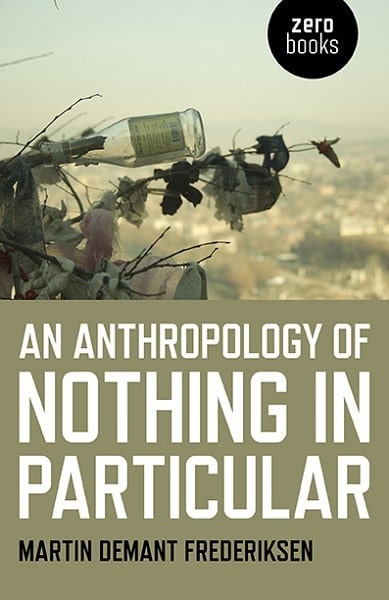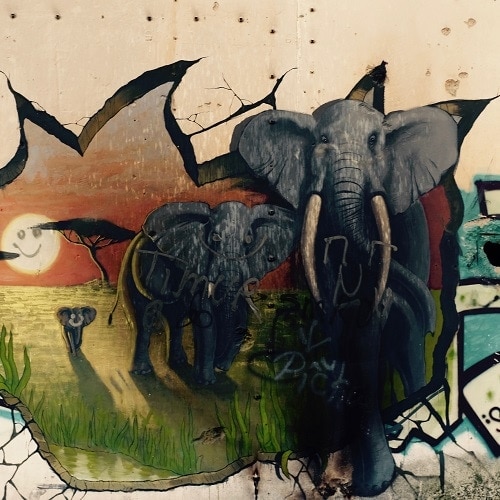Do the efforts to avoid meaningful action among young Nihilists in an undisclosed location make sense in a time where everything seems to be saturated with purpose? Does the task of writing a book about them? And,
how might anthropology that is otherwise concerned with the business of sense making be employed to study nothing, in particular?
 While I read Frederiksen’s book with great interest the task of writing a review of a book about nothing came across as a devious one. Either way I would end up offending someone: trying to make sense of the young nihilists would surely annoy them; among colleagues I would put myself in a tricky spot: either by recognizing the book’s rather unconventional form as sound and thus become complicit in undermining the revered format of the monograph. Conversely, should I not find it genuinely pointless I could end up upsetting Frederiksen himself of whose work I’m otherwise a great admirer. Due to my own longstanding interest in the dark side of optimism, the empty and absent, I decided to proceed, albeit with a precursory disclaimer of having to sieve my thoughts into parts that try to make sense of it and parts that don’t.
While I read Frederiksen’s book with great interest the task of writing a review of a book about nothing came across as a devious one. Either way I would end up offending someone: trying to make sense of the young nihilists would surely annoy them; among colleagues I would put myself in a tricky spot: either by recognizing the book’s rather unconventional form as sound and thus become complicit in undermining the revered format of the monograph. Conversely, should I not find it genuinely pointless I could end up upsetting Frederiksen himself of whose work I’m otherwise a great admirer. Due to my own longstanding interest in the dark side of optimism, the empty and absent, I decided to proceed, albeit with a precursory disclaimer of having to sieve my thoughts into parts that try to make sense of it and parts that don’t.
In the book we tag along with the author as he enters – or rather – as he is abducted into the lives of a small group of declared Nihilists in a capital somewhere. “Geography is pointless” (10), one of the protagonists realizes, which may point us to why placenames are absent throughout the book. Still, from the reoccurring theme of vodka, mentioning of Orthodox Christmas, angry priest-led mobs in the high spirit of anti-anti discrimination, and interlocutors’ cultural references we are likely to be somewhere in Eastern Europe.We are introduced to a heterogeneous group of characters though we gain a more intimate portrait of one in particular, Oz, whose apartment provides the backdrop for much of the talk, booze binging, chain smoking, haphazard ponderings on art, films, popular music, literature, and the occasional fistfight.
The book is thoroughly unstructured and despite its limited pages (110), comprises 10 brief chapters, and an impressive number of subheads (49): ‘yes we can’t!’, ‘diy pet cremation’, ‘Hakuna’s gone fishing’, ‘wallpaper frenzy’, ‘the later-day dude’, ‘whiskey starts writing’, and ‘imagine being a sober Gitte Nielsen’, just to mention a few. The exact genre to which the book itself belongs is rather difficult to pin down as it weaves in and out of humorously dark ethnographic vignettes, philosophical aphorisms, fiction, auto-ethnography, and more conventional engagements with the anthropological literature on youth, agency, purpose, and post-whatever.
While much is said and done on social movements, everyday forms of creativity and acts of resistance in the face of power and abrupt political transitions this literature tends to overshadow the perspectives of those genuinely disengaged and disinterested whose voices play a much less prominent role.
Following scholars such as Simon Chritchley and Deborah Durham, Frederiksen’s book takes important steps to make up for this analytical blind spot asking how nothing, Nihilism and meaninglessness, exist as components of social life?

Why, he asks, turning Lauren Berlant of her head, do some people not aspire towards ‘conventional good-life fantasies’ (92)? From the ethnographic encounter with the young nihilists, we shift from ‘cruel optimism’ to its less aspirational sibling, ‘joyous pessimism’ who is not so much prone to ‘thread water’ or drown but to breathe under it (91). In a similar way, Bourdieu’s illusio finds its conceptual counterpoint in a social world of dis-illusio i.e. actively refraining from ascribing meaning into one’s life and actions. Yet rather than positing the young groups’ inertia as the antidote to the contemporary over-saturation of meaning and purpose there is no real closure and with the deliberate omission of context the reader needs to make up her own mind.
While the nihilist stance inevitably presents a counter current to the undisclosed society’s position that nihilism and youths’ disengagement is a ‘major societal disease’ (45), we are pretty much left in the dark as to how nothing is financed? There seem to be no lack of drinks, cigarettes, tracks, films, or private spaces. And while food seems further down the line of consumption priorities this comes across as a matter of choice indicating some degree of privilege.
The particularity of nothing in this regard seems premised on a particular vantage point that may have benefitted from a different, or maybe simply a more varied range of ethnographic selection.
“Nobody likes nothing” (4), the author states paraphrasing Stanley Donwood’s slowly downward. That may be true. Still, the scope of nothing runs deep in the book as we are introduced to a motley crew of philosophical, political, literary and artistic roots seamlessly mixing tracks from Duran Duran, Pet Shop Boys, and Morrissey [through a conspicuous absence of his lyrics (21)] with insights from the group of young Nihilists along with Nietzsche, the Dude, Dostoevsky, Seinfeld, Sartre, Tarkovsky, Beckett, and with the brief but pleasant appearance of the author’s own kids. The author makes no claims as to the universality of the kind of nothingness that is experienced by the book’s protagonists. Instead, steps are taken to trace nihilism into its non-emancipatory form with the main concern of taking issue with the “modern ontology of purposefulness” (Hage in Frederiksen 2018, 74).

This brings us to a central merit of the book, that is its quixotic crusade against form and coherence in anthropological analysis. Although most of what happens (or that which doesn’t happen) takes place within the city, we never really stay in the same place for long and largely remain on the surface of things. To some measure, the lack of context aids to debase the currency of “thick description” while the scenes, protagonists, and atmospheres, nevertheless, stay with the reader. Framed as a crossbreed between experimental ethnographic fiction and the anthropological monograph, Frederiksen joins recent attempts to rethink the genre of conventional ethnography through ‘collaborative forms of imagination’, which I find to be the book’s most compelling contribution (3). Particularly the ‘fictocritical’ writings of Michael Taussig come to mind or that of Kathleen Stewart whose work carves out a eerie space for the incoherent, the vague, or the “things that don’t just add up, but takes on life of their own” (Stewart 2008, 72). This is an ingenious lateral move. Evidently, the book ‘gravitates towards nothing’. Yet Frederiksen’s gradual attunement into a world of nothing demands resolve and this occasionally results in relapse into making deep sense out of nothing and observable affection for squeaky-clean surfaces. Particularly memorable is “I heart Eucalyptus” where we hear of the author’s obsessive cleaning of windowpanes with vast supplies of a Eucalyptus-infused disinfectant. The uncanny kinship between the struggle to fight off fungus and anthropology’s habitual bent towards cleaning out the raw in the name of analytical clarity is hazy and not compromised by much explanation.
Some critics will surely find the book shallow as they scout the pages for context, argument, or clarity. What about race, gender or class? Isn’t this particular kind of nothing simply a bourgeois luxury afforded those with privilege?
Why did Oz friend-unfriend-friend the author? What does anthropology stand to gain from this radical method of collaborative imagination or ethnographic fiction? And what is lost? Undoubtedly the book raises more questions that it answers but in the spirit of Alice (the one in the hole) it is an intriguing detour. If nothing else, it’s a book to love or hate. Or both.
Should I ever be given the chance to add to the book’s already impressive line up of songs, Basinsky’s Disintegration Loops (1982, 2002) would make for a valuable B-side. The “Loops” came out of Basinsky’s efforts to digitize a small series of magnetic tape recordings extracted from an easy listening station in the early 80s. His attempts to salvage the recordings had the opposite effect with each rotation around the tape head only taring further on the already worn recordings. More than simply being an audio version of death by preservation, Basinsky’s recordings attest to how entanglements create new beginnings. Allegedly stunned by these new soundscapes of ruin and disintegration Basinsky allowed the loops to continue to the point of almost total dissolution. As the rifts and absences become more prominent the figure and ground trade places and we gravitate towards nothing.
In Frederiksen’s ‘anthropology about nothing’ there is a comforting letting go, a succumbing to the fungus, an amassing of things that do not add up. The book both humours and mesmerizes, amongst other things, by way of its immersive fiction as Whiskey writes, dolphins perform, and the hero of Oz rides away into lavender sunsets – with a clean shave, organic grape juice diets, a tan. Or something.
References
Basinsky, William. The Disintegration Loops I-IV, 2062, 2002-2003.
Durham, Deborah. 2008. ‘Apathy and Agency’ In: (Cole & Durham, eds) Figuring the Future. School for Advanced Research Press.
Critchley, Simon. 2004. Very Little…Almost Nothing – Death, Philosophy, Literature. New York: Routledge.
Stewart, Kathleen. 2008. Weak Theory in an Unfinished World. Journal of Folklore Research. 45. 71-82
Martin Demant Frederiksen, An anthropology of nothing in particular (Hampshire, Zero Books, 2018). Paperback. 118 pp., appendix, bibliography, ISBN 978-1-78535-699-5.
Featured image by Michael Ulfstjerne.



